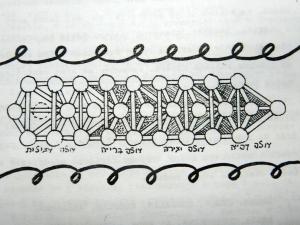Contributor(s): Shared on: Categories: Tags: | Contribute a translation | Source (English) |
|---|
|
[You can add personal affirmations to the following.] | | I affirm…The power of positive affirmations.
I affirm that the Shekhinah
Surrounds me,
And blesses me.
I affirm the light beings
Of God’s service,
Who support and guide me. |
אָבוֹת
| AvotI affirm the blessings
Of Avraham and Sarah, in my life. |
תְּחִיָּה
| T’ḥiyahI affirm the sacrifice of Yitsḥak,
And God’s power over my life,
And death. |
קְדֻשָּׁה
| ḲedushahI affirm God’s holiness,
And my growth toward it. |
שׁוֹבֵר אוֹיְבִים
| הָ Shover oyvimI place myself
Under the protection of the Sefirah of Keter,
Which will shield me
From all harm and neutralize it. |
אַתָּה חוֹנֵן
| הַ Atah ḥonenI invoke the inflow of Ḥochmah,
To align my intellect
With clarity and purpose,
To inspiration and realization. |
הֲשִׁיבֵנוּ
| הֵ HashivenuI invoke the care of Binah,
To lead me to God’s heart. |
סְלִיחָה
| הֶ SeliḥahI invoke the abundance of Ḥesed,
To bring me to atonement. |
גְּאֻלָּה
| הְ Ge’ullahI invoke the power of Gevurah,
To see me through trouble
And lead me to redemption. |
רְפוּאָה
| הוֹ Refu’ahI place myself
In the compassionate heart
Of God’s Tiferet,
And affirm the healing,
balancing, integrative,
Centering light within me. |
בְּרָכָה, מָשִׁיחַ, שְׁכִינָה
| הִ Brakhah, Mashiaḥ, ShekhinahI support myself
On the pillar of Netzaḥ,
Channeling to me
All manner of
Blessing and prosperity,
And place it at the disposal
Of the redeeming Mashiaḥ,
Unfolding to witness
The Shekhinah’s residing in Tsiyyon. |
קִבּוּץ גָּלוּיוֹת, יְרוּשָׁלַיִם, מוֹדִים
| הֻ Kibbutz Galuyot, Yerushalayim, ModimI support myself
On the pillar of Hōd,
Making order in my life,
Gathering all the forces
From dispersion,
And settling them
In the blessed Yerushalayim,
Where I offer my thanks
To God’s Glory. |
צְדָקָה וּמִשְּׁפַּת, צַדִּיקִים, שָׁלוֹם
| הוּ Tsedakah Umishpat, Tsaddikim, ShalomI base myself
On the foundation
Of Yesōd,
To act righteously and justly.
To assist
Every righteous effort
In the world,
And to become
Peaceful,
To work for peace. |
שׁוֹמֵעַ תְּפִלָּה
| ה Shome’a T’fillahI affirm that Malkhūt,
The Shekhinah, is the one
Offering these affirmations in me,
And is attracting
The flow of blessings,
To suffuse my life. |
אָמֵן…אָמֵן׃
|
Amen…Amen. |
Rabbi Zalman Schachter-Shalomi, z”l, included these Weekday Affirmations based on the Amidah, in his Siddur Tehillat Hashem Yidaber Pi (2009). I have replaced anglicizations and removed capitalization for divine pronouns. –Aharon N. Varady One might wonder where the practice of reciting daily affirmations intersects with Jewish prayer. These wikipedia articles on Affirmations (New Age) and especially, Affirmative Prayer provide some information on how affirmations have been used in the context of self-improvement movements, including the bygone Jewish Science movement. Reflecting on the language of these kabbalistic affirmations by Reb Zalman, I feel that he subverts the self-centered formulas typical of positive thinking “prayers” and centers the Jewish values of worldly tikkun through individuals taking upon themselves to act righteously and justly. Source(s)
 Rabbi Dr. Zalman Meshullam Schachter-Shalomi, affectionately known as "Reb Zalman" (28 August 1924 – 3 July 2014) was one of the founders of the Jewish Renewal movement. Born in Żółkiew, Poland (now Ukraine) and raised in Vienna, he was interned in detention camps under the Vichy Regime but managed to flee the Nazi advance, emigrating to the United States in 1941. He was ordained as an Orthodox rabbi in 1947 within the ḤaBaD Hasidic movement while under the leadership of the sixth Lubavitcher Rebbe, Yosef Yitzchok Schneersohn, and served ḤaBaD communities in Massachusetts and Connecticut. He subsequently earned an M.A. in psychology of religion at Boston University, and a doctorate from the Hebrew Union College. He was initially sent out to speak on college campuses by the Lubavitcher Rebbe, but in the early 1960s, after experimenting with "the sacramental value of lysergic acid", the main ingredient in LSD, leadership within ḤaBaD circles cut ties with him. He continued teaching the Torah of Ḥassidut until the end of his life to creative, free and open-minded Jewish thinkers with humility and kindness and established warm ecumenical ties as well. In September 2009, he became the first contributor of a siddur to the Open Siddur Project database of Jewish liturgy and related work. Reb Zalman supported the Open Siddur Project telling its founder, "this is what I've been looking forward to!" and sharing among many additional works of liturgy, an interview he had with Havurah magazine in the early to mid-1980s detailing his vision of " Database Davenen." The Open Siddur Project is proud to be realizing one of Reb Zalman's long held dreams. Read a comment / Leave a comment (moderated) Works of related interest: |












Leave a Reply